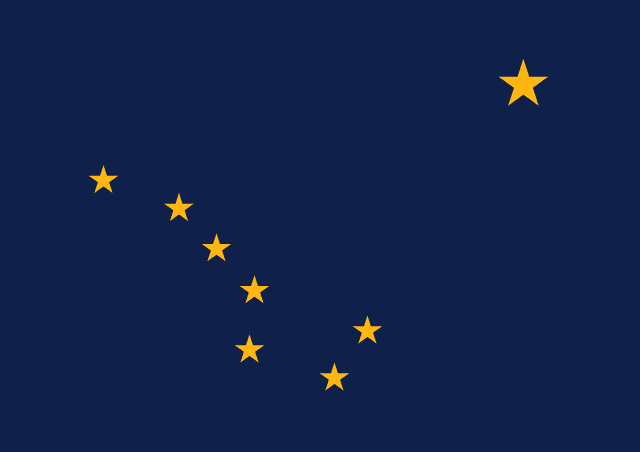State of Alaska
Nicknames: The Last Frontier, Land of the Midnight Sun
Motto(s): North to the Future
Date of Statehood: January 3, 1959 (49th state)
State Song: “Alaska’s Flag” by Marie Drake, music by Elinor Dusenbury
Alaska Flag History
The flag of Alaska, adopted for official state use in 1927, is a testament to the state’s unique identity and natural beauty. Designed by a 13-year-old native, Benny Benson, the flag’s simple yet profound symbolism and design beat out 700 other submissions in a 1927 contest. The flag features eight gold stars on a dark blue background. The stars form the Big Dipper, an asterism in the constellation Ursa Major, symbolizing strength, and the North Star, representing the northernmost state.
The deep blue field represents the sky, the sea, the mountain lakes, and the wildflowers of Alaska. The color was chosen for its contrast to the stars, symbolizing the state’s vastness and the wealth of potential it holds. The Big Dipper points towards the North Star, symbolizing guidance, steadfastness, and the unwavering spirit of the Alaskan people.
The adoption of the flag on July 9, 1927, marked the recognition of Alaska’s indigenous heritage and natural wonders. Despite Alaska’s statehood in 1959, the flag has remained unchanged, embodying the state’s historical and cultural journey. It reflects Alaska’s identity as a frontier of the untamed wilderness, rich traditions, and a beacon of hope and direction for the future.
Alaska Quick Facts
Capital City: Juneau
Abbreviation: AK
Population: Approximately 731,000
Region: West, Pacific Northwest
Origin of State Name: Derived from the Aleut word “Alyeska,” meaning “great land.”
Sports Teams: No major professional sports teams, significant presence in winter sports and the Iditarod Trail Sled Dog Race.
Bordering States: None (bordered by Canada, the Arctic Ocean, the Pacific Ocean, and the Bering Sea)
Area Codes: 907
Highest Point: Denali (Mount McKinley) at 20,310 feet (6,190 meters)
Lowest Point: Pacific Ocean
Geography of Alaska
Area: 663,268 square miles (1,717,856 square kilometers), 1st largest
Land: 570,641 square miles (1,477,953 square kilometers), 1st largest
Water: 92,627 square miles (239,904 square kilometers), 1st largest in terms of water area
Coastline: 6,640 miles (10,686 kilometers), 1st longest
Shoreline: 33,904 miles (54,563 kilometers), including islands, 1st longest
Largest Cities:
- Anchorage
- Fairbanks
- Juneau
- Sitka
- Ketchikan
- Wasilla
- Kenai
- Kodiak
- Bethel
- Palmer
- Homer
- Unalaska
- Barrow
- Soldotna
- Valdez
National Parks:
- Denali National Park and Preserve
- Glacier Bay National Park and Preserve
- Katmai National Park and Preserve
- Kenai Fjords National Park
- Kobuk Valley National Park
- Lake Clark National Park and Preserve
- Wrangell-St. Elias National Park and Preserve
- Gates of the Arctic National Park and Preserve
Alaska State Symbols
Living Insignia
State Bird: Willow Ptarmigan
State Animal: Moose
State Amphibian: Wood Frog
State Butterfly: None
State Fish: King Salmon
State Flower: Forget-me-not
State Horse Breed: None
State Insect: Four-spotted Skimmer Dragonfly
State Mammal: Bowhead Whale
State Reptile: None
Inanimate Insignia
State Fruit: None
State Gemstone: Jade
State Soil: None
State Tree: Sitka Spruce
State Quarter: Issued in 2008 featuring a grizzly bear with salmon and the northern lights
State Beverage: Milk
State Colors: Blue and Gold
State Dance: None
State Food: King Crab and Salmon
State Fossil: Woolly Mammoth
State Mineral: Gold
State Rock: None

